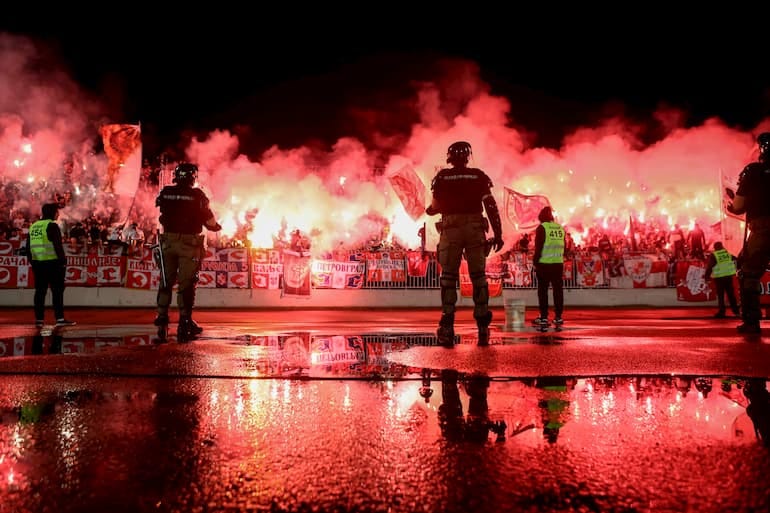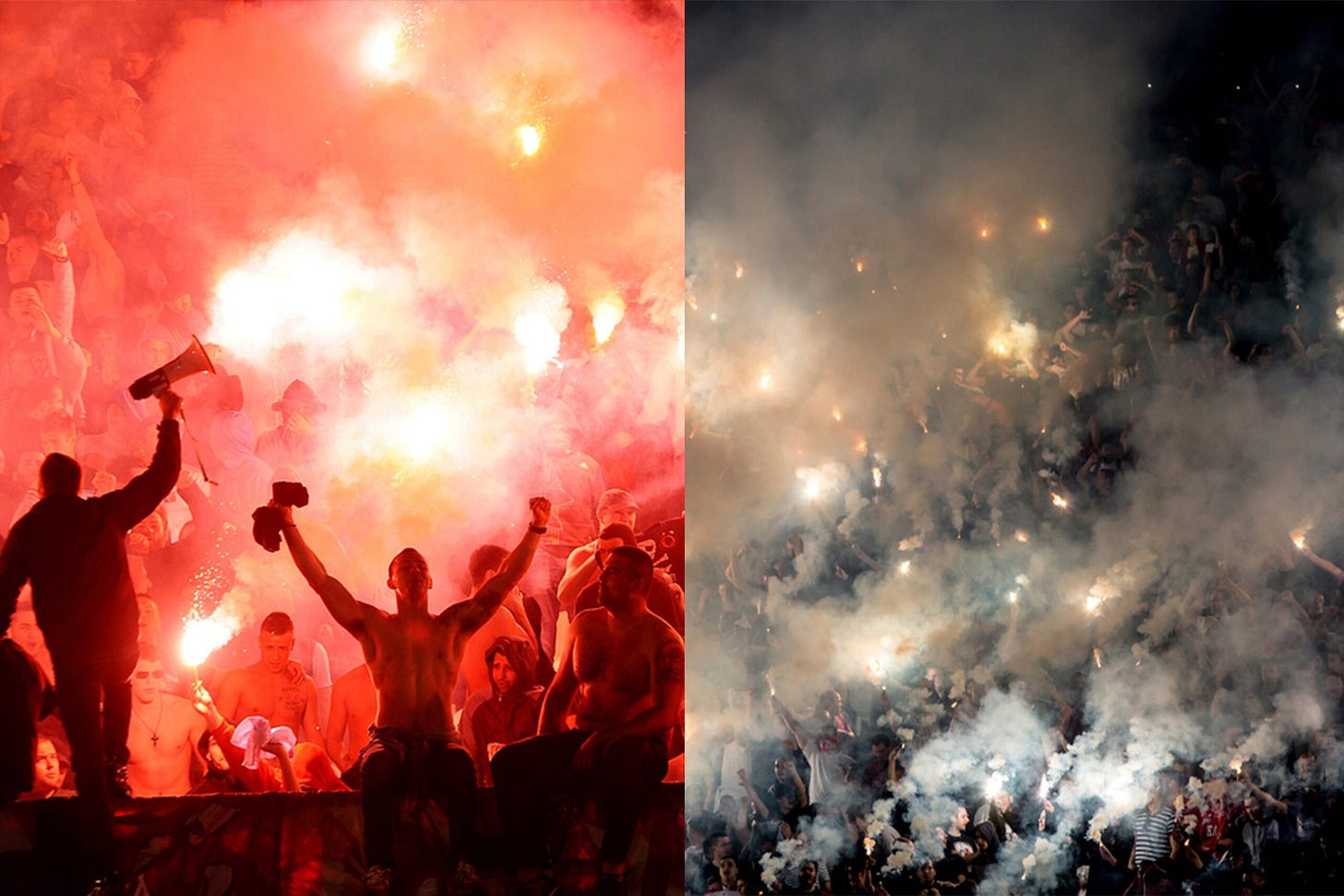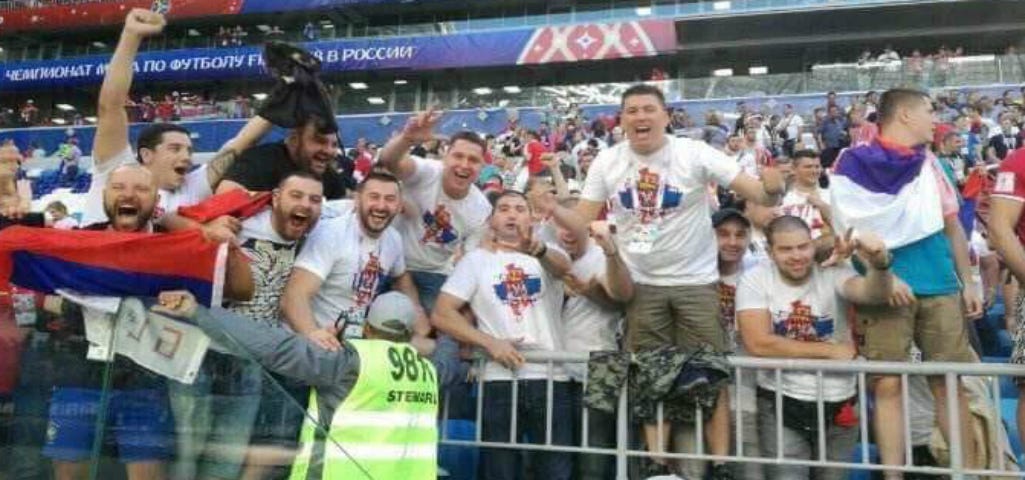S2E12. FK Hooligans Belgrade, ep. 1
This is the first episode in the heart of Serbian capital's brutal fandom. Red Star and Partizan hooligans are involved in organized crime, collusion with the power and ultranationalist violences
Hi,
welcome back to BarBalkans, the newsletter with blurred boundaries.
We left off last week with the Congress of European neo-fascists in Belgrade.
The environment where extremist, violent and racist ideas take root more easily is the Curva.
The home of hooligans. The home of fanatical football supporters.
The Serbian capital has one of the fiercest environments in the world, with two fans groups competing for the title of the most subversive Curva.
But first we need some context.
In this regard, I would like to share with you the draft of an article written for the Italian blog Calcio o Barbarie. It can provide a picture of the situation, before we dissect - in the next episode - the main issues of the hooligans underworld in Belgrade.
Enjoy the reading!
Twisted Curve
Flares, bolt-cutters and burning Kosovo flags. It was an evening of ordinary madness at the Marassi, in Genoa. The actors were the hooligans came from Belgrade to inflame the football match Italy vs Serbia, directed by a masked man. His battle name is “Coi”: the mask of Ivan Bodganov, the leader of the Red Star Belgrade hooligans.
It was October 12, 2010. More than a decade has passed, but it would naive to think that the same thing could not happen again today, at any time. At least if we’re talking about the toughest fans group in Europe: the Balkan one, in the capital city of Serbia.
From a socially and footballing point of view, Belgrade is no ordinary city. FK Partizan and FK Red Star have been challenging each other for 76 years now, in an atmosphere that is always a mix of fights to the death and civil war. To be clear, these are not figures of speech applied to the football world. It is the reality of two football fans groups dominated by exponents of organized crime and former paramilitaries who bloodied the Balkan region in the Nineties. Maybe this can remind you the Eighties’ atmosphere in the UK, under the siege of the hooligans. But here, we are dealing with a deeper level of aggression, with roots in a tragic past and projected into an uncertain future.
Thirty years ago, the wars that led to the dissolution of the former Yugoslavia began. Slovenia, Croatia, Bosnia and Herzegovina, Kosovo, Montenegro, North Macedonia and Serbia. A knock-on effect of human lives and machine guns led to the implosion of Marshal Josip Broz Tito’s Socialist Federal Republic. Hooligans carved out a prominent role as “butchers” of human beings, in war scenarios dominated by ethnic hatred. Sports fans represent an outlet for social tension. Serbian nationalist leaders were able to control that tension and transfer the violence from the Curve to the battlefield.
The most clear case was represented by the Arkan’s Tigers. The followers of Red Star’s hooligan leader, Željko Ražnatović, were framed in paramilitary squads, through a fierce discipline. With shaved heads and black tracksuits, Arkan’s men were responsible of several episodes of ethnic cleansing against the non-Serb minorities of Croatia and Bosnia (other Serbs paramilitary groups did the same in Kosovo). Hundreds of civilians were murdered, crossing the line of atrocity: Each Tiger had a sharp-edged spoon, that was used to rip the eyes from the heads of the victims, before killing them.
These were the men who returned to populate the north stand of Marakana in the 2000s, at the end of the wars. These were the men who inspired a new generation of Serbian hooligans, too young at the time of the Balkan slaughtering: such as the leader of the Ultra Boys, Ivan Bodganov. War criminals mixed with street criminals, from red-and-white Belgrade to black-and-white Belgrade.
Approximately nine months have passed since the attempted dismantling of an organized crime network rooted in drug and arms trafficking, money laundering and kidnapping. The organization is dominated by the Janissaries, a hooligan group supporting Partizan Belgrade. Its leader, Veljko Belivuk, is accused of ordering the murders of at least three rivals in the cocaine market. In a web of inter-clan conflicts linking the Serbian capital city with Kotor (reign of Balkan mafia in Montenegro), the Janissaries have transferred their power from the south stand of Partizan Stadium to the streets of Belgrade. They have made a deal with the authorities: a closed eye on their criminal affairs, in exchange for social peace. And they succeeded.
According to the investigation by prosecutor Saša Ivanić - a cornerstone for Serbian anti-mafia - the collusion of Belivuk’s organisation with the police and political circles goes beyond all expectations. It confirms that a hooligan group controlling one Curva in Belgrade can exercise actual power.
The most crucial person is Nenad Vučković, special advisor to the Gendarmerie (special police units). He allegedly provided logistical support and weapons to the Janissaries before and after the death of their historical leader, Aleksandar Stanković, in autumn 2016. And there is more. Thanks to Vučković - and a not exactly professional relationship - the former State secretary at the Home Office, Dijana Hrkalović, could be involved. It may be a coincidence, but during her mandate (ended in May 2019 without any explanation) the “war on mafia” declared in Serbia after Stanković’s murder exclusively targeted Serbian branches of the Montenegrin Škaljari clan. In other words, the rivals of the Montenegrin Kavač clan, affiliated with the Janissaries.
Up to the highest level. Sooner or later, President Aleksandar Vučić will have to respond for political accountability to his son’s restlessness. Danilo has well-established friendships with Partizan hooligans, especially with the most famous Janissaries: Milan Krasić, Aleksandar Vidojević and Boris Karapandžić, one of the most prominent names in the 4 February raid. The Serbian President’s 21-year-old son was captured saluting “Serbian style” (an ultranationalist gesture) and wearing T-shirts praising “no prisoners” in Kosovo. His stage was the football match Serbia vs Costa Rica, in the 2018 FIFA World Cup Russia. Another afternoon of ordinary madness for the Balkan football fandom. Another twist of the Curva.
Pit stop. Sittin’ at the BarBalkans
We have reached the end of this piece of road.
With our football discussions, in these two stops we will discover the bars bearing the two Belgrade football teams’ names.
Following the red thread of the hooligans, we end up in the United Kingdom. More precisely in Formby, a town a few kilometres from Liverpool.
Here we find the Red Star Brewery.
Founded in 2015, this craft brewery produces a range of products using the finest English malts and a selection of hops from all over the world.
The brewery won a gold medal at the SIBA Independent Beer Awards and it exports mainly to Serbia.
Another curious fact. On the counter of the Red Star Brewery we can find a dark beer with a caramel aftertaste and a familiar name: Partizan.
Just like the historical rivals of Marakana’s north stand.
Let’s continue the BarBalkans journey. We will meet again in a week, for the 13th stop and the analysis of the two Curve of Belgrade.
A big hug and have a good journey!
BarBalkans is a free weekly newsletter. Behind these contents there is a lot of work undertaken.
If you want to help this project to improve, I kindly ask you to consider the possibility of donating. As a gift, every second Wednesday of the month you will receive a podcast with an article about the dissolution of Yugoslavia.
Every month you can listen to the preview of BarBalkans - Podcast on Speaker and Spotify.
Pay attention! The first time you will receive the newsletter, it may go to spam, or to “Promotions Tab”, if you use Gmail. Just move it to “Inbox” and, on the top of the e-mail, flag the specific option to receive the next ones there.
As always, I thank you for getting this far with me. Here you can find all the previous newsletters.
BarBalkans is on Facebook, Twitter and Instagram. The updated archive is on Linktree.








